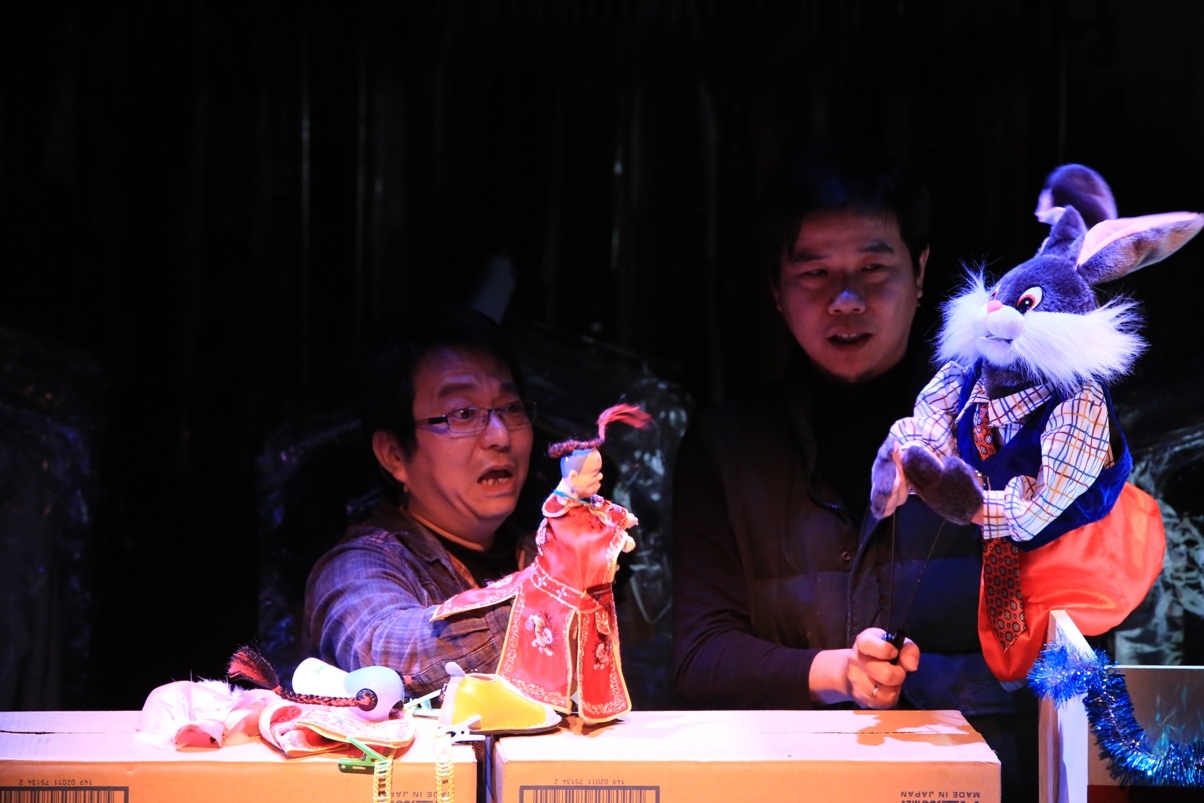《聊齋,聊甚麼哉?》在國寶級大師陳錫煌師傅指導下,山宛然與弘宛然布袋戲團特邀劇團導演王嘉明與編劇林建華共同創作,以現代劇場手法塑造嶄新風貌的「媚怪布袋戲劇場」,打破傳統彩樓的框架,將演師、樂師請出幕後,鑼鼓樂串絲竹樂,讓布袋戲裡的每一個元素更為鮮活靈動。
選用《聊齋》中的故事,以情感與欲望為內在主軸,從感官六識出發,結合彩樓組件的表演,鬼、神、妖、狐勾引人的眼、耳、鼻、舌、身、意,在黑盒子空間裡,發揮前所未有的狂想空間。導演將場景設定為洗衣店,四面掛滿各式衣物,彷彿正是隱藏於布袋戲彩樓後的一尊尊戲偶;以演師的精湛技藝為本,加上真人演員的穿插,共同塑造人偶、空間異質對話的黑色喜劇。
山宛然劇團/弘宛然劇團/導演王嘉明 Shan Puppet Theater / Hong Puppet Theater / Director: WANG Chia-Ming
製作及演出:黃武山,莒光國小「微宛然」第一屆團員,現為「山宛然客語布袋戲團」團長,並在多所學校擔任布袋戲講師。吳榮昌,曾向陳錫煌、李天祿習藝,現為「弘宛然古典布袋戲團」團長,目前除演出,也從事教學工作。導演:王嘉明,「莎士比亞的妹妹們的劇團」團長。作品《膚色的時光》獲第八屆台新藝術獎表演藝術大獎。
Production and Performance: HUANG Wu-shan was the first-generation member of Wei Wan Jan puppet troupe of Juguang Elementary School. He is the current director of Shan Puppet Theater, as well as a puppet theater teacher in various schools. WU Rong-chang had been a pupil under CHEN Xi-huang and LI Tian-lu, and is the current director of Hong Puppet Theater. In addition to performances, he also teaches the art of the puppet theater.
Director: WANG Chia-ming is the current director of Shakespeare’s Wild Sisters Group. His work, Once, Upon Hearing the Skin Tone, won the annual grand prize of performing arts in the eighth Taishin Arts Award.
弘宛然、山宛然
陳錫煌
王嘉明
林建華
高豪杰
江佶洋
柯智豪
鄭沛民
吳榮昌、黃武山、陳威璁
吳朋奉
吳威豪、陳萱華、張月娥、蔡武哲
黃珮舒
王婷儀
林岱蓉
廖曉珮、林家榕、偕志語、陳建宇
賴忠志
林馨
國家戲劇院實驗劇場
關鍵字
- 傳統戲曲
- 現代劇場
- 布袋戲
- 乾洗店
- 聊齋
- 偶
- 318學運
藝術家談作品
透過這齣戲,我想表達的另一個重點,就是布袋戲的美。
王嘉明:「透過這齣戲,我想表達的另一個重點,就是布袋戲的美。」
評審談作品
解決掌中戲進入現代劇場的觀賞距離難題。
入圍理由 Reason for Nomination
四折古典《聊齋》傳統布袋戲,鑲嵌入一則現代「洗衣店有鬼」演出場景裡,人、鬼、衣、偶,交相隱喻,實幻穿越,既是人操演偶,又是人(導演)操演人,大敘事框架裡置入小敘事,大視覺景框內伸縮變出小舞台,加上「318學運」同步發生著卻被場上演員以遙視(影像)、倒述口氣說出,時間、空間、敘事均幻覺化,暗喻了政治幻象及歷史幽靈化,魅影敘事從一而終。此外,導演透過幻覺手法調動景框變化,讓觀眾自動伸縮觀視,不僅更加凝練掌中技藝之美,更解決掌中戲進入現代劇場的觀賞距離難題,於作品及劇種美學意義上備極難能可貴。 提名觀察人:紀慧玲
The four-act classic, Liaozhai (Strange Tales from a Chinese Studio), presented in traditional puppet theater was embedded in a modern dramatic scene of “ghosts in a laundry shop.” Humans, ghosts, clothing, and puppets became metaphors for one another, piecing together a realistic yet phantasmal, time-travelling play—a play that was presented by puppeteers manipulating puppets as well as a person (the director) manipulating other people, and with minor narratives within the main narrative, and small stages displayed within the large visual frame. In addition, the “March 18 Student Movement,” which was taking place at the time, was narrated in flashback by the performers as they remotely viewed the incident (in images). Time, space and narratives were all made illusions, signaling the political illusions and the spectrally rendered history; the phantasmagorical narrative was carried out through the play. Furthermore, through the illusory change of frames, the director allowed the possibility for the audience to automatically adjust their perspective, not only refining the beauty of hand puppetry, but also resolving the difficulty of viewing when puppet theater entered the modern theater. This is highly commendable in terms of the performance and the aesthetics of the genre. Nominator: CHI Hui-Ling






